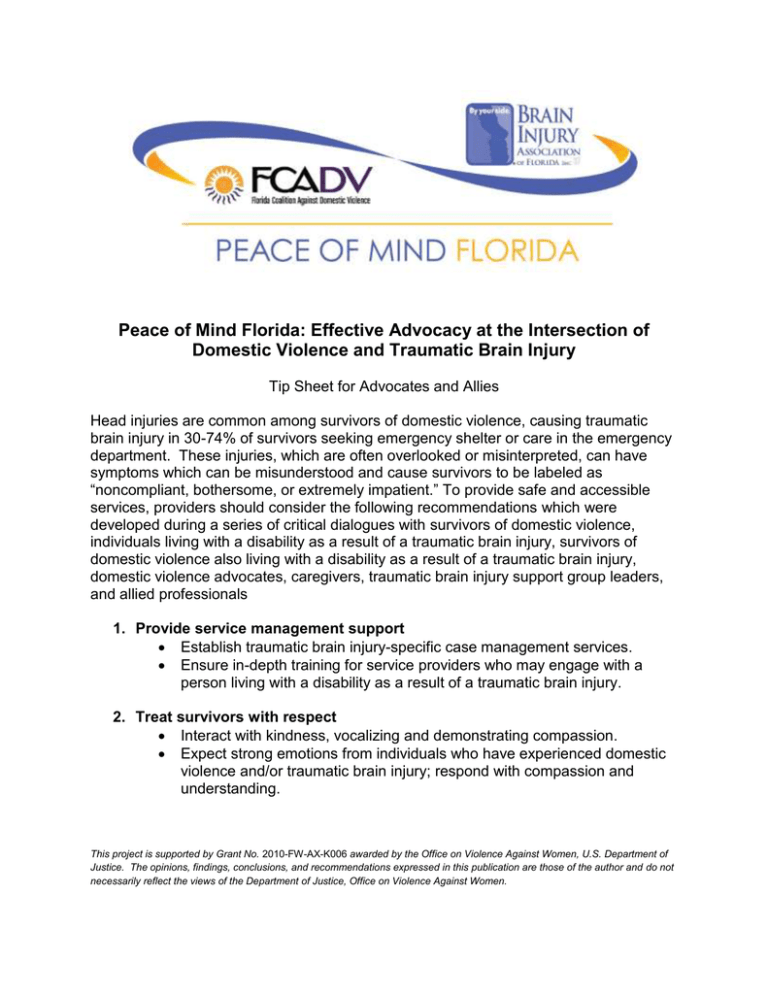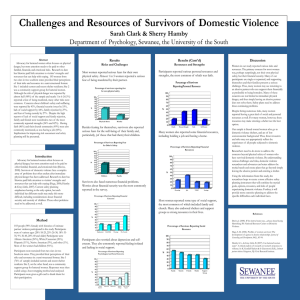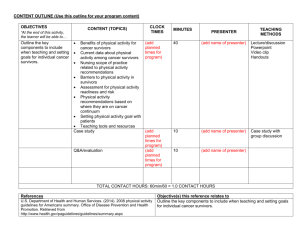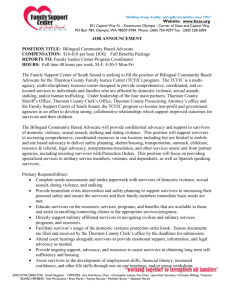Tip Sheet for Advocates and Allies
advertisement

Peace of Mind Florida: Effective Advocacy at the Intersection of Domestic Violence and Traumatic Brain Injury Tip Sheet for Advocates and Allies Head injuries are common among survivors of domestic violence, causing traumatic brain injury in 30-74% of survivors seeking emergency shelter or care in the emergency department. These injuries, which are often overlooked or misinterpreted, can have symptoms which can be misunderstood and cause survivors to be labeled as “noncompliant, bothersome, or extremely impatient.” To provide safe and accessible services, providers should consider the following recommendations which were developed during a series of critical dialogues with survivors of domestic violence, individuals living with a disability as a result of a traumatic brain injury, survivors of domestic violence also living with a disability as a result of a traumatic brain injury, domestic violence advocates, caregivers, traumatic brain injury support group leaders, and allied professionals 1. Provide service management support Establish traumatic brain injury-specific case management services. Ensure in-depth training for service providers who may engage with a person living with a disability as a result of a traumatic brain injury. 2. Treat survivors with respect Interact with kindness, vocalizing and demonstrating compassion. Expect strong emotions from individuals who have experienced domestic violence and/or traumatic brain injury; respond with compassion and understanding. This project is supported by Grant No. 2010-FW-AX-K006 awarded by the Office on Violence Against Women, U.S. Department of Justice. The opinions, findings, conclusions, and recommendations expressed in this publication are those of the author and do not necessarily reflect the views of the Department of Justice, Office on Violence Against Women. Exhibit a large amount of patience, recognizing that this is a necessary accommodation to allow adequate time for clear communication, especially during times when strong emotions are being expressed. Avoid the appearance of being dismissive. Keep commitments. Return phone calls. Ensure appropriate follow through. Design accessible buildings and programs, both in their physical structures and in the way that people are treated by reception staff and building security. 3. Offer community and survivor education Offer training opportunities for service providers to help them learn about the impacts of domestic violence and traumatic brain injury. Develop materials for use by caregivers to help them better understand the needs of domestic violence survivors and individuals living with disabilities as a result of traumatic brain injury. Provide online resources for survivors and for service providers which include information about relevant laws and regulations. 4. Use person-first language and person-centered planning Implement empowerment-based advocacy models, which centralize the survivor by using person-first language and person-centered planning. Train providers about service strategies which promote survivors’ right to self-determination, allowing them to self-define goals and service plans Help survivors plan for implementing their goals. Give information in a non-judgmental manner. Avoid the re-establishment of systems of control and dominance. 5. Give survivors an opportunity to provide feedback and evaluate services for effectiveness Develop methods to regularly collect and analyze feedback from survivors. Use survivor feedback to improve accessibility and programming for individuals and systems. Distribute feedback surveys often in order to capture information about the experience of people accessing services. Utilize various methods to receive feedback from survivors, such as interviews, focus groups, and on-line surveys. This project is supported by Grant No. 2010-FW-AX-K006 awarded by the Office on Violence Against Women, U.S. Department of Justice. The opinions, findings, conclusions, and recommendations expressed in this publication are those of the author and do not necessarily reflect the views of the Department of Justice, Office on Violence Against Women. 6. Ensure timely and widely available services Advocate for legislation to expand funding for services for survivors of domestic violence and individuals living with a disability as a result of traumatic brain injury. Pay special attention to advocacy in the areas of housing, transportation, and service companions. Advocate for systemic improvements to reduce wait times for disability/Supplemental Security Income (SSI) benefit approvals. Use the broadest possible interpretation of service definitions to meet multiple needs of survivors. 7. Promote testing and diagnosis availability Increase funding for neurological research and nutrition and alternative treatments for traumatic brain injury. Seek and disseminate information regarding visual tests to distinguish between learning disabilities and traumatic brain injury. Improve dissemination of information about existing treatments and options. 8. Create a holistic service approach Establish partnerships among various sectors to expand services. Collaborate to better meet the unique needs of individuals. Cross-train staff who work with domestic violence survivors and staff who work with individuals with disabilities as result of a traumatic brain injury. o Include information about how to help survivors identify and understand triggers and develop skills to cope with reaction to triggers when experienced. o Discuss confidentiality in a comprehensive manner, providing information about how to promote trust with survivors and strategies to navigate confidentiality and privacy issues with caregivers. Publicize services effectively and in multiple formats. Provide services in person when possible to ensure clear communication. Encourage visual and auditory interactions. 9. Promote community among survivors, including peer support Develop and publicize formal and informal opportunities for survivors to network. Offer support groups. Promote social activities for survivors and include survivors in the planning stages of the activities. This project is supported by Grant No. 2010-FW-AX-K006 awarded by the Office on Violence Against Women, U.S. Department of Justice. The opinions, findings, conclusions, and recommendations expressed in this publication are those of the author and do not necessarily reflect the views of the Department of Justice, Office on Violence Against Women. 10. Communicate clearly and often Train staff and caregivers about communication skills needed to effectively engage with an individual living with a disability as a result of a traumatic brain injury. Role play to practice using clear, direct, and repetitive language. Ask for information to be repeated back to ensure clarity and mutual understanding. Ask about needed accommodations in the following manner: o First describe the event/activity o Then solicit accommodation requests Use clear and concrete language, avoiding abstraction and nuance. Help survivors thoughtfully plan by: o Offering possible options and solutions o Discuss potential outcomes and consequences of available options Offer resources that contain step-by-step instructions, or assist survivors with creating step-by-step instructions to achieve desired personal goals. Peace of Mind Florida is a collaboration between the Florida Coalition Against Domestic Violence (FCADV) and Brain Injury Association of Florida (BIAF). In October 2010, as a result of the Office of Violence Against Women (OVW) Disability Grant Program, FCADV and BIAF joined together to form Peace of Mind Florida. Peace of Mind Florida is a partnership designed to address how FCADV and BIAF will increase their capacity to provide training and technical assistance at the intersection of domestic violence and traumatic brain injury to its membership, staff and allied professionals. This project is supported by Grant No. 2010-FW-AX-K006 awarded by the Office on Violence Against Women, U.S. Department of Justice. The opinions, findings, conclusions, and recommendations expressed in this publication are those of the author and do not necessarily reflect the views of the Department of Justice, Office on Violence Against Women.








